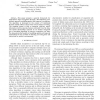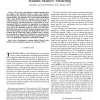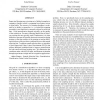335 search results - page 23 / 67 » Improving the DISPGB algorithm using the discriminant ideal |
IROS
2007
IEEE
14 years 1 months ago
2007
IEEE
— This paper presents a general framework for multi-sensor object recognition through a discriminative probabilistic approach modelling spatial and temporal correlations. The alg...
ICIP
2009
IEEE
14 years 8 months ago
2009
IEEE
We consider the problem of head tracking and pose estimation in realtime from low resolution images. Tracking and pose recognition are treated as two coupled problems in a probabi...
TSP
2008
13 years 7 months ago
2008
We present a discriminative training algorithm, that uses support vector machines (SVMs), to improve the classification of discrete and continuous output probability hidden Markov ...
ICASSP
2010
IEEE
13 years 7 months ago
2010
IEEE
Supervised learning uses a training set of labeled examples to compute a classifier which is a mapping from feature vectors to class labels. The success of a learning algorithm i...
GECCO
2008
Springer
13 years 8 months ago
2008
Springer
The study of common, complex multifactorial diseases in genetic epidemiology is complicated by nonlinearity in the genotype-to-phenotype mapping relationship that is due, in part,...



